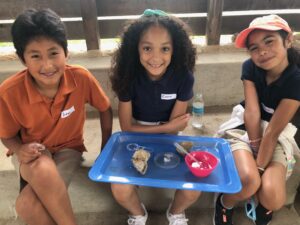UT Elementary’s STEAM (Science, Technology, Engineering, Art and Math) class was awarded a $607 grant from the National Park Trust. This award covers the cost of admission and bus rental for both 4th grade classes to visit the Ladybird Johnson Wildflower Center with their classroom and STEAM teachers. The Wildflower Center has highly engaging field trips that are directly tied to the Science standards for each grade.
But as this was a STEAM trip, what makes UT Elementary’s field trip different from other schools?
STEAM teacher Ms. Calvin explained that the 4th grade had been studying the types of pollinators in the classroom: bees, butterflies, hummingbirds, etc. The docents from the Wildflower Center explained that certain pollinators were attracted to certain flowers because of their shape or color. For example: bees prefer sturdy flowers that can support their weight, butterflies prefer larger flowers to support their wingspan, and hummingbirds look for red flowers. Back in the classroom, Ms. Calvin had the students engineer and construct flowers to reflect the specific needs of a designated pollinator in an activity that truly shows students how science, engineering and art are connected in the real world.
At the Wildflower Center, the students made wildflower seed balls. Those balls of mud and seeds will be tossed in the wild area at the east end of the school and their growth will be recorded over the next year. Some of the seeds will quickly germinate but some will wait until the ideal temperatures of fall or winter before they begin to sprout. This activity correlates well into the mathematical concepts of graphing and describing and analyzing through measurement.
The 4th graders have something to look forward to in the fall when they return for their final year at UT Elementary.
Subvención del Fideicomiso del Parque Nacional
La clase STEAM (Ciencia, Tecnología, Ingeniería, Arte y Matemáticas) de la Escuela Primaria UT recibió una subvención de $607 del National Park Trust. Este premio cubre el costo de la admisión y el alquiler del autobús para que las dos clases de 4to grado visiten el Centro de Flores Silvestres Ladybird Johnson con su salón de clases y los maestros de STEAM. El Wildflower Center tiene excursiones muy atractivas que están directamente relacionadas con los estándares de Ciencias para cada grado.
Pero como este fue un viaje STEAM, ¿qué hace que el viaje de la Escuela Primaria UT sea diferente de otras escuelas?
La maestra de STEAM, Ms. Calvin, explicó que el cuarto grado había estado estudiando los tipos de polinizadores en el salón de clases: abejas, mariposas, colibríes, etc. Los docentes del Wildflower Center explicaron que ciertos polinizadores se sintieron atraídos por ciertas flores debido a su forma o color. Por ejemplo: las abejas prefieren flores resistentes que puedan soportar su peso, las mariposas prefieren flores más grandes para soportar la envergadura de sus alas y los colibríes buscan flores rojas. De vuelta en el salón de clases, la Sra. Calvin hizo que los estudiantes diseñaran y construyeran flores para reflejar las necesidades específicas de un polinizador designado en una actividad que realmente muestra a los estudiantes cómo la ciencia, la ingeniería y el arte están conectados en el mundo real.
En el Widflower Center, los estudiantes hicieron bolas de semillas de flores silvestres. Esas bolas de barro y semillas se arrojarán al área silvestre en el extremo este de la escuela y se registrará su crecimiento durante el próximo año. Algunas de las semillas germinarán rápidamente, pero otras esperarán hasta las temperaturas ideales de otoño o invierno antes de comenzar a brotar. Esta actividad se correlaciona bien con los conceptos matemáticos de gráficas, descripción y analisis a través de la medición.
Los estudiantes de cuarto grado tienen algo que esperar en el otoño cuando regresen para su último año en la Escuela Primaria UT.



